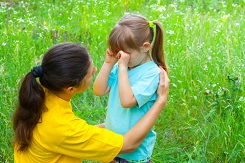 It is likely your child may act out or have an emotional outburst at some point, maybe even on a regular basis. However, many times, children do not even understand why they’re feeling or reacting the way they are because they do not know the basics about feelings.
It is likely your child may act out or have an emotional outburst at some point, maybe even on a regular basis. However, many times, children do not even understand why they’re feeling or reacting the way they are because they do not know the basics about feelings.
As a parent or nanny, it’s important to educate your children about how feelings operate and how we can control our actions. Allowing your child to express himself and learn that feelings are a natural part of life can ultimately help minimize the emotional outbursts or tantrums that occur.
Feelings: A Learned Skill Over Time
Even though your child will not remember his younger years, his emotional regulation actually began as an infant when he began discovering nurturing relationships. “Through repeated interactions with caregivers, babies learn that their distress can be tolerated and contained,” says Jeanette Sawyer Cohen, a licensed clinical psychologist and child development counselor in New York City.
“Babies internalize the quality of their earliest relationships and, over time, learn to self-soothe as a way to manage their own distress,” says Sawyer Cohen. “Emotion regulation is an aspect of healthy social-emotional development.”
Babies learn about feelings and emotions when primary caregivers provide emotional stability. This stability is achieved by attuning to the child’s cues and responding to an infant’s cries.
Once a child enters the toddler and preschool years, his life is surrounded by socialization. He then learns how to channel his feelings in socially appropriate ways, says Sawyer Cohen. “Children at this age need parents, teachers and other involved adults to give them words for their big feelings,” she says. “As children develop expressive language skills, they are better able to tell us what they feel rather than show us with their behavior.”
Limit setting and redirecting, when needed, can go hand-in-hand with labeling feelings, says Sawyer Cohen. Provide your child with the phrases he or she needs to express those feelings. For example, you can say, “I can see you’re angry, but it’s not OK to push.” Or, as a child begins to pull toys off a shelf, parents or nannies can say, “I can see you want to be really messy right now. Let’s build a big block tower and crash it down.”
These phrases give the child the consistent message that the feeling itself is OK while the behavior may or not be, says Sawyer Cohen.
Beyond frustrations and emotions tied to play, children often experience strong feelings when faced with separation. “Separation is often on the minds of young children,” says Sawyer Cohen. “Help them cope by giving voice to their experience.”
Carefully worded phrases to validate feelings and redirect a child’s energy can help him or her cope, such as “I can see you’re really missing daddy right now. Did you know he’s thinking about you, too? Let’s draw a picture to show him when he gets home.”
Games and picture books also help children understand and recognize how feelings work. In the early years, you can teach children about feelings with simple picture books. “Young children begin to ask ‘what’ questions before ‘how’ or ‘why,’” says Sawyer Cohen. “School-age children can be taught to identify not only facial expressions (the ‘what’) but also how it feels to be sad or mad in the body.”
For children with language skills, it is important to speak their language. “They might not relate to adult terms like ‘loss’ or ‘anxiety,’ but may talk instead of ‘the missing feeling’ or a ‘nervous tummy,’” says Sawyer Cohen.
Even many kindergartners are able to describe the physiological aspects of emotions, such as changes in heart rate and breathing. Therefore, children can be taught to notice the intensity of their feelings on a scale of 1 to 10 or by coloring a feelings thermometer, says Sawyer Cohen. It is also helpful for them to know that they can feel more than one feeling at a time.
Regardless of how you choose to teach your child about feelings – through books, games or discussions, for example – the key is to make sure that you give them the opportunity to experience their feelings naturally and resist the urge to scold them for expressing how they feel. “Learning to identify and express emotions is a key aspect of social-emotional development, which paves the way for successful relationships and academic learning,” says Sawyer Cohen.
← 100 Life Lessons to Teach Kids | Date Night on a Dime →
Leave a Reply